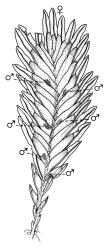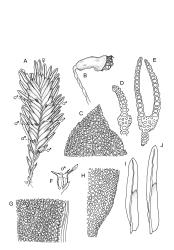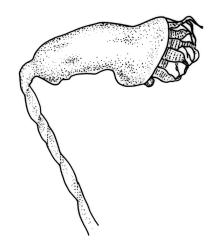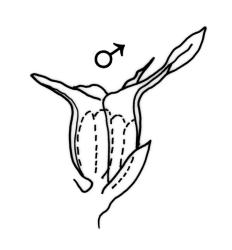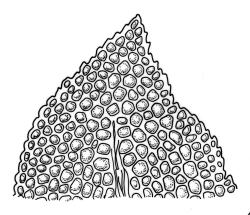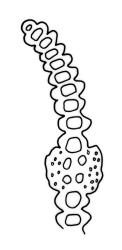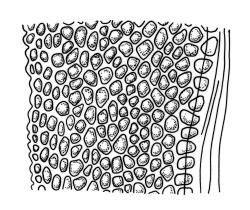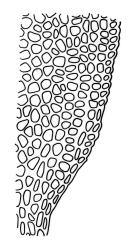Plants 5–25 mm, mid green to yellow-green, sometimes black below, loosely gregarious. Stems frequently branched by means of innovations from below terminal gametoecia, with rhizoids at base only. Leaves in 15–30(–40) pairs, overlapping at mid stem, patent, plane when moist, with leaf apices ± loosely inrolled towards the substrate when dry, ligulate, 1.7–3.0 × 0.20–0.35 mm; apex broadly acute; laminae unistratose; vaginant laminae ½–⅔ leaf length, partially closed to closed; dorsal lamina often failing above leaf insertion, tapered to its base; margins serrulate-crenate on apical, dorsal and vaginant laminae, with cells of supra- basal vaginant lamina margins isodiametric to oblate; cells of apical and dorsal laminae irregularly hexagonal, smooth, strongly bulging, with moderately thick walls, (6.0–)8.0–11.0(–15.0) × (6.0–)8.0–11.0(–15.0) µm. Costa failing below leaf apex, oblongifolius-type in cross-section.
Gonioautoicous. Perichaetia terminal on main stems and innovations, leaves longer than vegetative. Perigonia axillary on fruiting stems, bulbiform, conspicuous. Setae light brown, strongly twisted when dry, 5–10 mm; capsules horizontal to inclined, moderately to strongly asymmetric, 0.5–1.0 mm; operculum rostrate from a conic base, equal in length to theca. Peristome similiretis-type; teeth 68–90 µm wide at base. Calyptrae and mature spores not seen in N.Z. material.
Wilson 1854, pl. 83, fig. 8; Catcheside 1980, fig. 23; Beever & Stone 1998, figs 2, f, 5, d, f, 6, a–k, 7, d–e; Beever et al. 2002, p. 50, figs 1–6 (as F. oblongifolius var. oblongifolius); Stone & Catcheside 2012.
Hooker & Wilson (1844) described F. oblongifolius and F. capitatus as new species, both based on Bay of Islands types collected by J.D. Hooker. In the protologue F. oblongifolius is stated to differ from F. capitatus "in the linear obtuse leaves, of firmer texture, and more intense yellowish green colour; also in the position of the perigonia". Subsequently, F. capitatus was reduced to a variety of F. oblongifolius (Hooker 1867), with the only distinguishing feature mentioned being leaf shape: "linear, ligulate, obtuse" in var. α [oblongifolius], vs "linear-lanceolate, acuminate" in var. β [capitatus].
Dixon (1923) and Sainsbury (1955) both accepted F. capitatus as a variety of F. oblongifolius, but with reservations.
For his part, Sainsbury (1955, p. 53) commented, "I have seen very little of this species or of the variety, both having been seldom collected in New Zealand." He cites two localities for the species, "Poor Knights Islands" and "Bay of Islands". The former record is no doubt based on L.B. Moore 657, with duplicates in WELT-Sainsbury and CHR. That collection is a mixture of F. leptocladus, F. asplenioides and F. curvatus, and the present author found no F. capitatus in it. The only "Bay of Islands" specimen identified as F. oblongifolius in the Sainsbury Herbarium is a specimen (V.W. Lindauer s.n., WELT M007726) collected in Nov. 1940 "in cave beneath Rainbow Falls, Keri Keri", but that specimen is F. strictus Hook.f. & Wilson.
Dixon (1923, p. 106) considered the differences in the shape of the leaf apex, as described by Hooker, were "often not well marked" and that "intermediate forms occur". However, all N.Z. material labelled "F. oblongifolius var. capitatus" in Herb. Dixon (excluding types) is incorrectly identified in my opinion: of the three specimens, two are F. pallidus and the third F. waiensis. A further specimen labelled by Dixon as "F. asplenioides" is F. oblongifolius s.s. Thus the concepts both G.O.K. Sainsbury and H.N. Dixon had of F. oblongifolius s.l. were compromised.
Fissidens capitatus and F. hyophilus were reduced to synonymy of F. oblongifolius by Bruggeman-Nannenga et al. (1994), and later treated as varieties of F. oblongifolius by Beever & Stone (1998). Further familiarisation with all three taxa, in the field and the herbarium, leads me to the conclusion that all three are distinct in ecology and morphology, with no intermediate forms observed among more than 100 specimens, and hence deserving of specific status. Numerous additional synonyms proposed for F. oblongifolius by Bruggeman-Nannenga et al. (1994) (but not recorded for N.Z.) have not been considered for this treatment.
Fissidens oblongifolius can be distinguished from F. capitatus by its broadly acute leaf apices, and the failure of the dorsal laminae above the leaf insertions. When present, the bulbiform perigonia in leaf axils along the stem (clearly visible with a hand-lens on moist plants) will distinguish the species from all other N.Z. species of Fissidens except F. bryoides (which has bordered leaves) and F. taylorii var. epiphytus (which has leaves variably bordered, and is a much smaller plant).
Distinguishing features between F. oblongifolius and F. asplenioides and F. hyophilus are described under those species.
NI: N Auckland, including offshore islands (GB, RT), Ch (Chatham I.).
Australasian? Tasmania*, mainland Australia*, New Caledonia*. Recorded from Vanuatu by Suzuki & Iwatsuki (2002). A much wider geographic range is implied by the extensive synonymy for F. oblongifolius proposed by Bruggeman-Nannenga et al. (1994). With the exception of its presence on Wharekauri/Chatham I., all N.Z. records are from north of latitude 37°S. The published record from the Poor Knights Is (Beever 1986) was based on misidentification of F. hyophilus.
On soil or rock in indigenous forest. Mostly on stream banks or emergent boulders in streams, either shaded or exposed in canopy gaps. Plants sometimes silted indicating periodic flooding. Annotations such as on a "dripping face" and "on dripping wet rock" occur. Associated mosses include Campylopus clavatus, F. asplenioides, F. tenellus and Mniodendron colensoi. Records of F. oblongifolius range from near sea level to c. 200 m (Surville Cliffs, N Cape, N Auckland L.D.).
The species is notable as a coloniser of shaded lava on Rangitoto I., the youngest volcano in the Auckland volcanic field, erupting c. 600 years ago (Hayward et al. 2011). There, F. oblongifolius is found under a forest canopy, or in crevices within the still extensive bare lava fields. In such crevices, F. oblongifolius and associated bryophytes, together with water-retaining gelatinous desmids and cyanobacteria, have been observed acting as a substrate for seed germination and early development of Metrosideros excelsa, the major forest tree species on the island (Whiting 1986; Beever & Malcolm 2007). The early colonisation of lava fields by microorganisms and bryophytes may thus account for the successful establishment of Metrosideros spp., which are the primary vascular plant colonisers on such lava fields.
The species is classified as "Naturally Uncommon" in the N.Z. Threat Classification System (Glenny et al. 2011), and is infrequently collected. However, the strong similarity of sterile material to F. asplenioides (which is very common, widespread, sometimes associated, and usually sterile) makes identification problematic in the field, and F. oblongifolius is likely to be under-recorded.
An account of F. oblongifolius in N.Z. was given by Beever & Stone (1998).



